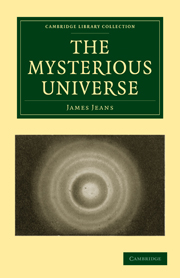III - Matter and Radiation
Published online by Cambridge University Press: 07 September 2010
Summary
In the early days of science, the unquestioning acceptance of the law of causation as a guiding principle in the natural world led to the discovery and formulation of laws of the general type “an assigned cause A leads to a known effect B.” For instance the addition of heat to ice causes it to melt, or stated in more detail, heat decreases the amount of ice in the universe and increases the amount of water.
Primitive man would become acquainted with this law very easily—he had only to watch the action of the sun on hoar-frost, or the effect of the long summer days on the mountain glaciers. In winter he would notice that cold changed water back into ice. At a farther stage it might be discovered that the re-frozen ice was equal in amount to the original ice before melting. It would then be a natural inference that something belonging to a more general category than either water or ice had remained unaffected in amount throughout the transformation
ice → water → ice.
Modern physics is familiar with laws of this type, which it describes as “conservation laws.” The discovery we have just attributed to primitive man is a special case of the law of conservation of matter. The law of “conservation of X,” whatever X may be, means that the total amount of X in the universe remains perpetually the same: nothing can change X into something which is not X.
- Type
- Chapter
- Information
- The Mysterious Universe , pp. 40 - 69Publisher: Cambridge University PressPrint publication year: 2009First published in: 1930



